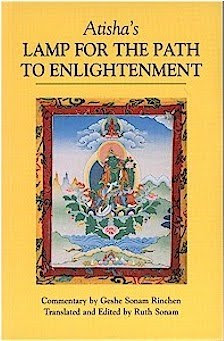Overcoming Contradictions in the Dharma Teachings
 There are many instances where the Buddha said one thing, and then later said exactly the opposite. How do we understand exactly what we are supposed to do, and which advice do we follow first? To help us, great Atisha wrote the first Lam Rim around the year 1000, which is a guide to the Buddhas teachings in the order needed to gain realizations. It is called “Lamp for the Path” and is still available in bookstores, in many languages. This is a small book, and naturally, as things go on, you get big books out of small books. It should work the other way around, but it does not.
There are many instances where the Buddha said one thing, and then later said exactly the opposite. How do we understand exactly what we are supposed to do, and which advice do we follow first? To help us, great Atisha wrote the first Lam Rim around the year 1000, which is a guide to the Buddhas teachings in the order needed to gain realizations. It is called “Lamp for the Path” and is still available in bookstores, in many languages. This is a small book, and naturally, as things go on, you get big books out of small books. It should work the other way around, but it does not.Later teachers have taken the format of Lam Rim, to present their own extensive commentaries on the Buddhas teachings, some of which have become quite famous. “Lam Rim Chenmo” by Je Tsongkapa, “Liberation in the Palm of Your Hand” by Je Phabonka Rinpoche and “Words of My Perfect Teacher” by Patrul Rinpoche are only a few of the many Lam Rims.
Generally, the primary teachings or the introductory teachings of Buddhism are self-directed. By understanding the nature of our own suffering we can learn about the workings of karma within the existential problem that we have. We should be interested in rearranging our life for developing a spiritual life, such as daily meditation. Gradually, by following the stages of the path, we come to a flowering of our own understanding.
In our Gelug tradition, we see refuge as being foundational to Lam Rim studies. Only after understanding refuge, leisure, endowments, eight worldly thoughts, and many other basic teachings, and integrating them, will we then come to, “How do I develop compassion?” These subjects generally are at the end of Lam Rim; developing compassion and bodhichitta, the mind of enlightenment, as a result of earlier foundational insights. This is how a firm basis makes us steady enough to learn the transcendent subjects! ~Domo Geshe Rinpoche~~~


Comments
Post a Comment
I appreciate your comments- find a minute or two (for members of this blog) to share your views